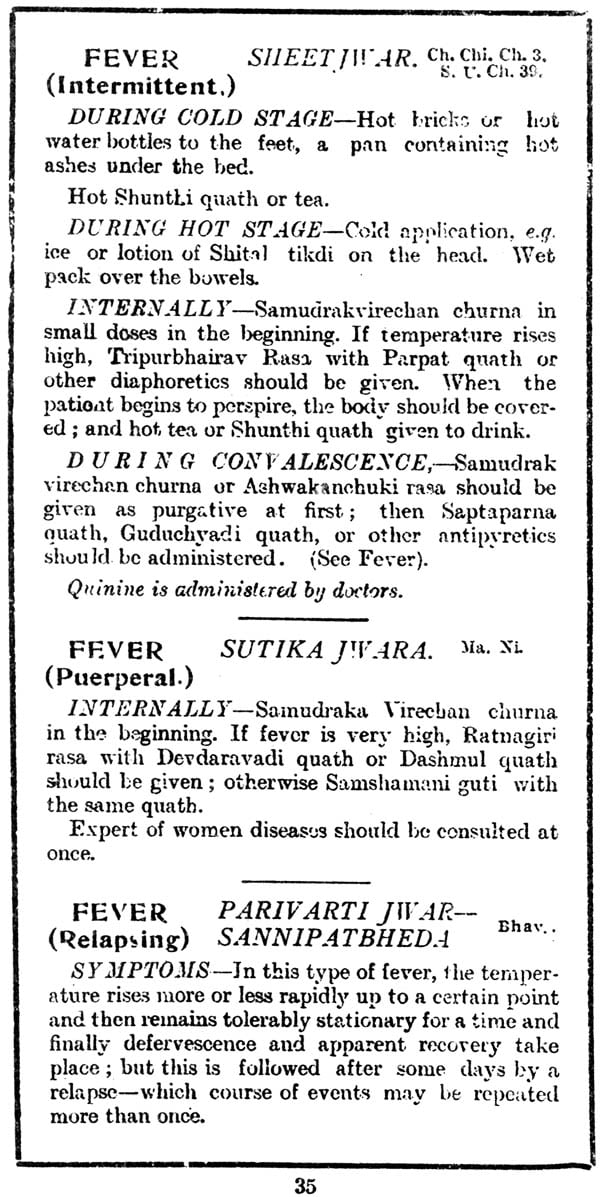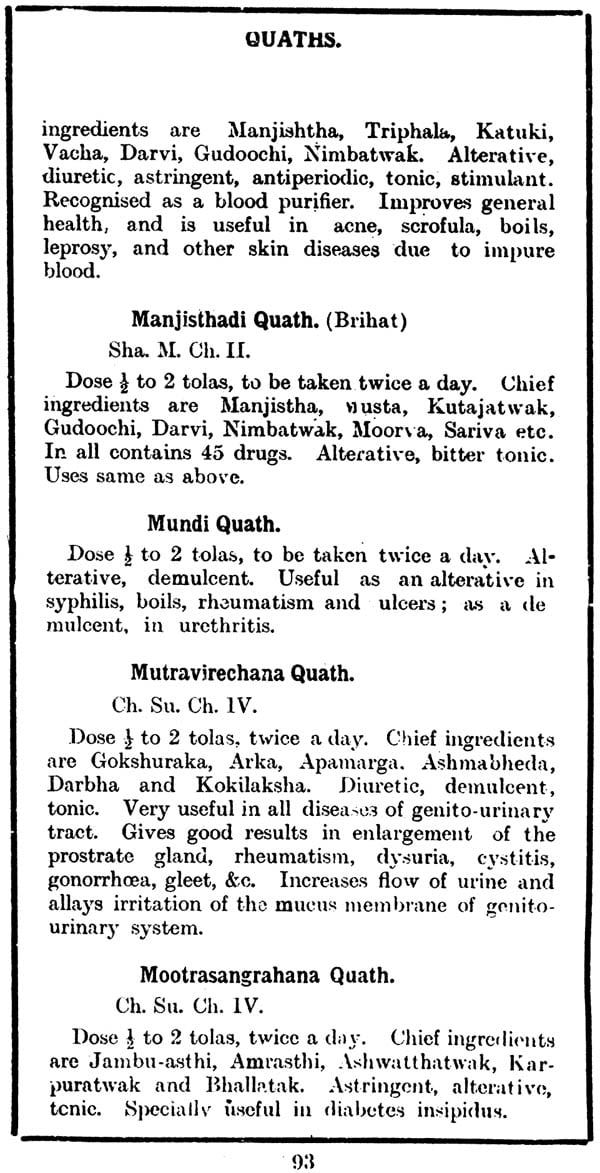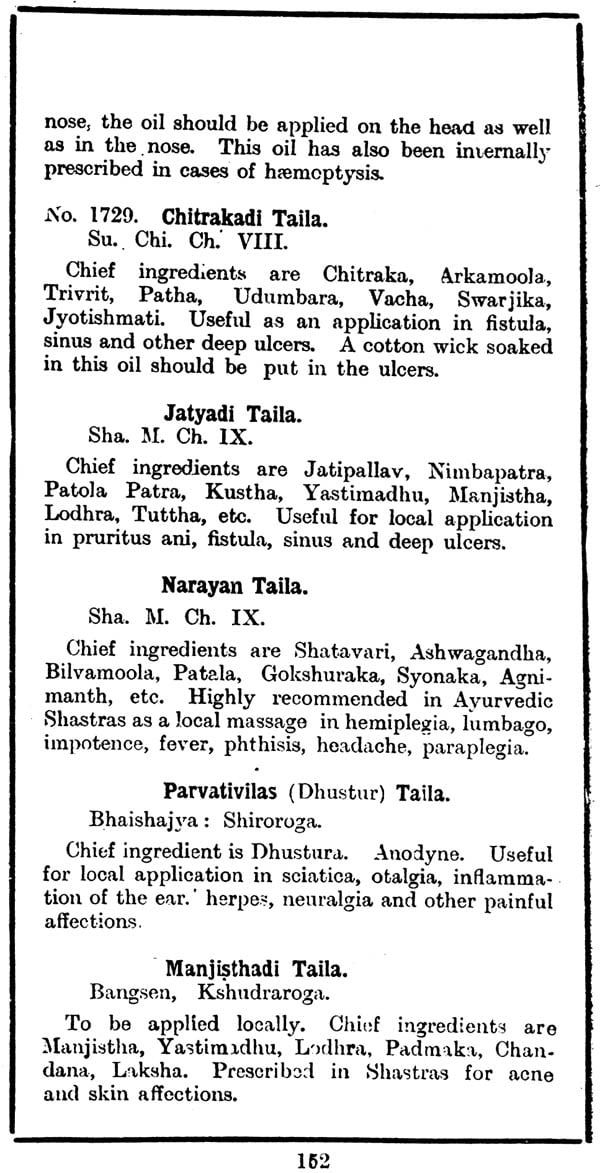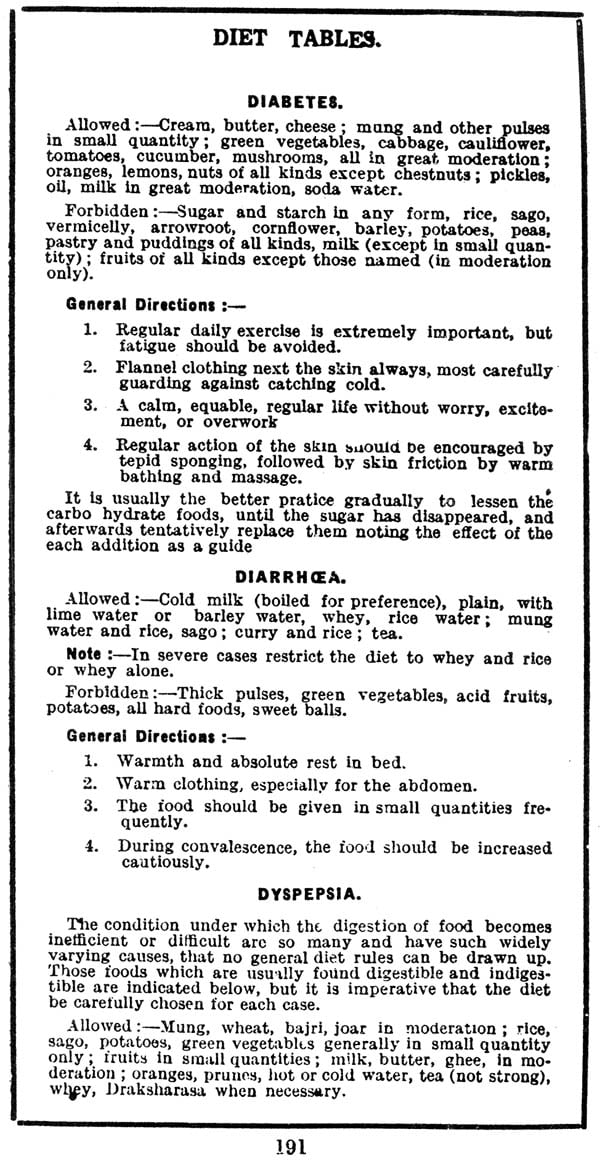
Clinical Application of Ayurvedic Remedies and A List of Ayurvedic Preparations
Book Specification
| Item Code: | IHL416 |
| Publisher: | Sri Satguru Publications |
| Edition: | 1998 |
| ISBN: | 8170301017 |
| Pages: | 208 |
| Cover: | Paperback |
| Other Details | 8.5 inch X 5.6 inch |
Book Description
From the Book
This book is actuated by two motives. In the first place to supply to native physician a sort of the guide in their profession. The-original works of Ayurvedic medicine are in Sanskrit; there are very few reliable translations of these works. In the second place, many doctors have latterly taken to the use of native drugs either out of respect to our Ayurveda or the patient demand them. These doctors have no time to study the Sanskrit texts of Ayurvedic medicine and their scientific training does not allow them to make experiments on human lives, of A drugs about which they know nothing definite. In prepaing this book the prescriptions were taken from Charaka, Sushruta, Vriddha, Vag Bhatta, Astanghridaya, Rasahridaya, Sharangdhar, Bhavprakash, Rasa Ratna Samuchachaya, Yoga Ratnakar, Bhaishajya Ratnavali, Nighantu Ratnakar and . Other, and for symptoms of diseases Madhav Nidhan is consulted. This book is made up of three divisions. (l) An index of diseases (2) an index of medicines, and (3) miscellaneous information for Vaidyas. The Index of `the diseases is alphabetically arranged and an index of their Sanskrit names is given at the end. So that one can easily find the treatment, of any disease, if one knows- either its English or Sanskrit name. In the second division, decoction, powders, pills, tablets, confection etc. are shown separately, and then under each heading, they medicines are arranged alphabetically; so that if any one knows whether a particular drug is a pill or decoction or Powder he can find it out at once under its proper heading. For other there is also a general index of all the drugs at the end. In the third divison, hints are given as to the general regimen in different cases, urine examination, tables of weights and measures etc. A separate chapter on diet has been included. The doses prescribed herein are only general and will require modification, in particular cases. The dose depends upon the condition of the patient, the stage of the disease, the age of the patient, his habit etc. A short chapter on diagnosis of diseases by urine examination is also included. The book will be of immense use to general reader as well to the practitioner of medicine
Preface
In preparing this brochure we are actuated by two motives. We intend in the first place, to supply to our native physicians a sort of guide in their profession. The original works of Ayurvedic medicine are in Sanskrit; there are very few reliable translations of these works. Again the order of arrangement in these works is such that one could not get a complete treatment of any one particular subject in any one work. Owing to this and many other reasons, our native physicians are in great want of such a guide book.
In the second place, many doctors have latterly taken to the use of our native drugs, either out of respect to our old Ayurveda or because their patients demand them. These doctors have no time to study the Sanskrit texts of Ayurvedic medicine and their scientific training does not allow them to make experiments on human lives, of drugs about which they know nothing definite. Our aim is to supply this information of the Shastric method of using native drugs to- our respected clientele of this class.
In order to fulfil both these aims at the same time, we have made the use of the comparative method. At first sight, it may appear impossible to institute a comparison between the old Ayurveda developed by the ancient Rishis more than two thousand years ago, and the system of European medicine that is being developed at such rapid strides in this age of scientific progress. But a slight reflection will help to dispell such pessimistic ideas. It has to be remembered that the basis of both the systems is ‘experience.’ ‘Western medicine has certainly taken very rapid strides in Anatomy, Physiology, &c., because we possess today instruments for very minute and accurate observations, such as were not even dreamt of in those days. Hence the physiology of Ayurveda based on mere outward observation, has no lessons to teach to the new physiology studied with the help of the most elaborate instruments. But treatment is chiefly a subject of experience, and it is probable that in this broad expanses of India, the Rishis may have derived an extended experience of many diseases. So that in this sphere, it is possible to use the method of comparison. We may make this a little more clear by an example or two. Doctors recommend in high fever some kind of cold treatment. Ayurveda also recommends the same. “Dividing” fevers into cold and hot, such treatment as cold bath, application of some cooling substance, or dripping some cold liquid continuously for a long time should be used, as may be necessary." Charaka. Again, "physicians treat diseases due to heat by cold producing agents." (Ibid.) Thus Ayurvedic and European "medicines are at one in recommending cold treatment in the heat of fevers. It is natural that the particular substance recommended for inducing cold will be different in the different cases. The old Rishis used Chandan-sandal, lotus, cold water, &c.; to-day we can get ice in plenty and so use it; but the basic principle of both is the same, viz:—induce cold and lower temperature in the heat of fever.
Sushruta recommends surgery in dropsy, stone, cancer, intestinal obstruction, &c. European medicine also recommends surgery in these cases. The treatment of snake bite in both _systems is the same, vis: to open the wound and cauterise it. To stop vomiting, doctors recommend sucking ice: Charaka re- commends very ‘cold’ water. The ancient Aryans used bael fruit in cases of dysentery two thousand years ago, and to-day the doctor recommends the same. Such instances may be extended to an enormous length. Discriminating readers will thus be able to see that in the treatment of diseases, it is not difficult to compare the East with the West. How far the comparison given in this pamphlet has been justified can only be determined by learned physicians and eminent doctors after somewhat extended experience. This is a first attempt in this direction, and as such, is bound to have many defects. We shall be highly obliged if doctors and Vaidyas will help us to weed out its defects by suggestions and improvements.
In preparing this brochure, we have freely drawn upon the inexhaustible store given to us by the ancient Rishis. We have taken prescriptions from Charaka, Sushruta, Vriddha, Vag Bhatta, Ashtang hridaya, Rasa hridaya, Sharangdhar, Bhavprakash, Rasa Ratna Samu- chchaya, Yoga Ratnakar, Bhaishajya Ratnavali, Nighant Ratnaker, &c., and for symptoms of diseases, we have also consulted Madhav Nidan. For comparison with Western medicine, we have used Moore’s Family Medicine, Dula Foy’s Practice of Medicine, Robert’s Practice of Medicine, Vhitla’s Dictionary of Treatment, Sharir by Dr. T. M. Shah, &c. For the English equivalents of the Sanskrit names of diseases, we have taken the help of Dr. Garde’s Marathi rendering of Madhav Nidan, and the Madhav Nidan with commentary, 4th Edn., published by the Nirnaya Sagar Press, Bombay. We have also made some use of the list of Welcome, Abbot, Park Davis, &c. Over and above these, we have also drawn upon the practical experience of a very high order. The proprietor of this concern has inherited a very widely extended medical practice, and he has a wide experience of Western and Eastern methods of treatment, which has been used in the preparation of this work. Several kind friends have also given us the benefit of their experience and learning, among whom we must mention Vaidraj Vishvanath Vithalji, State Physician to H. H. the Thakore Saheb of Morvi, Vaid Jadavji Tricumji Acharya, editor of Ayurvedic Granthmala, Vaidraj Prabhulal Prabha- shanker, Vaidraj Amritlal Pranshanker. An- other kind friend Dr. S. K. Vaidya, L.M. & S., has gone through the conspectus of diseases from beginning to end. Our best thanks are due to these gentlemen for their suggestions. In Bombay, this -city of multi-sided activities and interests, consultations between doctors and Vaidyas are of ordinary occurrence, and if at such times, this small brochure helps both of them to understand each other better than before; we shall consider our pains to have been well taken. This digest is made up of three divisions. (i) An index of diseases, (2) an index of medicines, and (3) miscellaneous information for Vaidyas. The index of diseases is alphabetically arranged, and an index of their Sanskrit names is given at the end. So that one can easily find the treatment of any disease, if one-knows either its English or Sanskrit name. In the second division, decoctions, powders, pills, tablets, confections, &c., are shown separately, and then under each heading, the medicines are arranged alphabetically; so .that if any one knows whether a particular drug is a pill or decoction or powder, he can find it out at once under its proper heading. For others, there is also a general index of all the drugs at the end. In the third division, we have given hints as to the general regimen in different cases, urine examination, tables of weights and measures, &c
In the medical guides nowadays ‘it has become customary to give general hints as to temperance in the satisfaction of the appetites when prescribing various medicines for diseases. But diet has relation with disease and not with medicine. It is true that in some very hot medicines like marking nuts, some particular things are especially prohibited, e.g., when marking nuts are being taken, capsicum and, even exposure to the sun leads to eruptions. But such drugs are few and far between, and even in their case, it taken in proper dose, there is not much danger. But in some diseases, diet has a special significance, e.g., diabetics pass sugar in their urine, hence they should avoid in their food, sugar or any other substances which generally are transformed into sugar. Thus diet has a special relation with diseases and in some cases is a very important element in the treatment of diseases, but ordinary general hints are a useless burden on the patient. In this brochure, we have given in a separate chapter only those hints as to diet, which according to the above rule, are necessary in the various diseases, and some special hints in the use of particular medicines like nuts, have been given in short, in the section dealing with these drugs. Such general remarks that "temperance in the satisfaction of bodily appetites preserves health, and want to it brings on disease," are principles of ordinary health and should not be confounded with dietetics. It is needless for example, when prescribing a particular drug, to advise avoidance of oven eating; over-eating-is bad in all cases, and does not need a special precaution in any particular disease. Dose.
The doses prescribed herein ere only general and will require modification, in particula cases. The dose depends upon the condition of the patient, the stage of the disease, the age of the patient, his habits, &c. Vagbhatta says in Ashtang Kalpa Ch. VI. "There is no general rule as to the dose; the dose must be deter- mined by a consideration of the disease, the constitution of the patient, his strength, his age, the character of the country and time." Modem Vaidyas do not stick to the old regulation of the Shastras—of prescribing 4 tolas; buy they have modified it to suit modem times. We also have given the usual doses to be 5 to 20 grains, 1 to 4 pills, 1 to 4 tolas, &c.—in the ratio of 1 to 4. So that r represents the minimum and 4 the maximum dose for an average adult. We have not indicated separate doses for children, but in a general table, indicated the usual modifications for ages 1 month to years; so that from the dose for adults, a man may determine the dose suitable to his age. Some useful hints as to the dose and the effects of particular drugs are also given in the third part.
| Preface | i-viii |
| Clinical Application of Ayurvedic Remedies Price List of Ayurvedic Preparations : | 1-84 |
| Quaths | 87-96 |
| Churnas (Powder Mixtures) | 97-116 |
| Pills | 117-128 |
| Tablets | 129-138 |
| Avalehas (Confections) | 139-143 |
| Ghritas | 144-147 |
| Ointments | 148-149 |
| Tailas | 150-154 |
| Rasas (Mercurial Preparations) | 155-174 |
| Bhasmas | 175-178 |
| Asava-Arishta | 179-181 |
| Miscellaneous Preparations | 182-183 |
| Vocabulary of Sanskrit drugs into Latin | 184-188 |
| Diet Tubbs | 189-195 |
| Poisons and their Antidotes | 195-197 |
| Pulse Rate | 197 |
| Temperature | 198 |
| Indian end English Weights Compared | 198-199 |
| Doses Proportionate to Age | 199 |
| General Instructions | 199-200 |
| Index | 201-208 |









